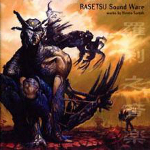Rasetsu Sound Ware
 |
Album Title: Rasetsu Sound Ware |
| Record Label: Kogado Studio |
|
| Catalog No.: KGMC-004 |
|
| Release Date: March 25, 2002 |
|
| Purchase: Buy Used Copy |
Overview
Rasetsu Sound Ware is a short soundtrack composed by Hiroto Saitoh, Kayoko Maeda, and Maki Fujiwara for the PC game, Guren Tentsuki: Rasetsu. It features a variety of styles, but does the music make it worth a purchase?
Body
Hiroto Saitoh is the primary contributor to the soundtrack and contributes a variety of styles. “Topaz” opens with some choral chanting, giving a holy atmosphere to the intro of the track; however, as the track progresses, the tone of the piece is changed entirely with some classic rock inspired electric guitar riffs and solos, vocoders, and synthesizers It’s not the most melodic of pieces, as it mainly focuses on creating a ton of energy through its various components, but it’s an entertaining listen nonetheless.
“Phenomena” is even more experimental than Saitoh’s opening contribution. It features some interesting drum n’ bass work that I’d expect to hear from k.h.d.n., together with striking piano and haunting choral parts. It’s an atmospheric track, for sure, but it really doesn’t grab the attention of the listener, especially if they are looking for something with a bit of a melodic push. “Scapegoat” opens up with some fast-paced tribal percussion and some strings work to get the atmosphere going. As the track progresses, the ominous male vocals and angelic sounding female vocals offer a fascinating contrast. In the end, it’s another atmospheric track with a fantastic soundscape, but also a track that doesn’t manage to encapsulate the listener either.
There are few more atmospheric tracks that manage to impress. “Silent Terra” is another atmospheric track that combines an R&B beat with jazz, rock, and electronic elements. It’s a theme that does a fantastic job of creating a stunning mood and engaging the listener throughout its duration, unlike some of the other atmospheric tracks featured. “Different Water” prominently features the use of water sound effects. In addition to this, there is a definite Asian soundscape provided through the use of woodwinds. Combine this with some fantastic electronic accompaniment, some female vocals, and some fun, and it’s a compelling listen that really manages to succeed in providing an exhilarating aural experience.
“The Beautiful Deformity” continues Saitoh’s rock focus. Unlike “Topaz,” the guitar riffs in this one are a bit heavier. In addition, there are some ominous choral tones and sinister organ work that make up the majority of the track. It isn’t the most melodically focused, but it does manage to capture your attention through its sound. “The Revelation” features some fantastic elements as well. The choral work, sinister organ, operatic vocals, synth leads, and a rock/electronica focus make this theme one for the books. Lastly, “Inspiration” is a driving electronic theme with some vocal samples interspersed throughout its duration. It doesn’t really have too much of a melody, but it does provide an entertaining listen, nonetheless, due, in part, to the jazzy keyboard solo thrown into the mix.
“Carona,” by Maki Fujiwara, is an interesting track. The electronic accompaniment sounds like a chaotic mess, intentional or not. It also features prominent xylophone parts and a pulsating rhythm created through beats and drums. It doesn’t really do much, as gradually builds and builds, but there isn’t really any payoff. Maki Fujiwara’s second contribution, “Tribal Dance,” incorporates tribal percussion, natural sound effects, and some electronic accompaniment, but in the end, it doesn’t really manage to make an impact either. Kayoko Maeda’s sole contribution to the soundtrack is “Hard Shot.” It’s a theme that manages to create an energetic atmosphere through its driving rhythm, synth keyboard work, rock accents, and orchestral overtones. In the end, it’s a more enjoyable theme and one of the stronger contributions on the soundtrack.
Summary
In the end, the Rasetsu Sound Ware album is a short album providing a variety of styles. Unfortunately, aside from a few themes, most of which by Hiroto Saitoh, the album doesn’t really stand too strong on its feet. I enjoy how Saitoh approached it with a mult-genre mindset and it’s really nice to hear him do rock oriented themes, even if they aren’t melodically focused ones. As for the assistant composers, I felt that Kayoko Maeda impressed while Maki Fujiwara floundered. It’s tough for me to recommend this album, but if you are a diehard fan of the music if you heard it in-game, then by all means, get it.
Do you agree with the review and score? Let us know in the comments below!
2.5
Posted on August 1, 2012 by Don Kotowski. Last modified on August 1, 2012.














